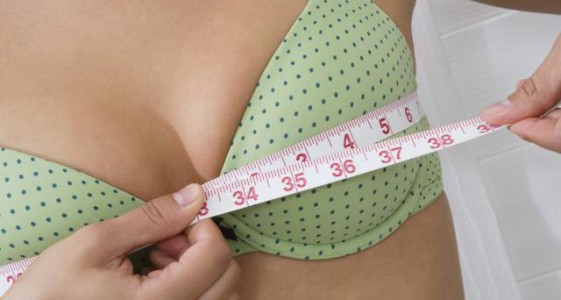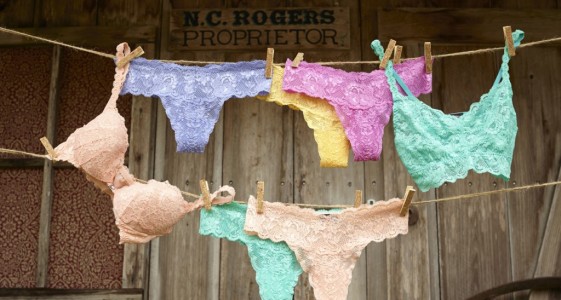
SIZING
To estimate your approximate bra size is pretty simple, you just need a tape measure and a mirror. First, measure the diameter of your chest just below the bottom of the bra. The tape measure should have no slack, but not be overly tight. Exhale so that you capture the minimum size of your chest, making sure the tape is parallel to the ground. Record that measurement.
Next move the tape around your chest again, this time measuring with the tape at the midpoint of your cup, once again adjusting it so that the tape is parallel to the ground. Record the second measurement in inches.
The first measurement provides your approximate band size (e.g., 32, 34, and all the way up to 46 or beyond). Band sizes are only measured in multiples of two. The measurement estimates your cup size. The general rule of thumb is that for every inch the second measurement is greater than the first, the cup size will go up by one letter. If the second measurement is one inch, you’re approximately an “A” cup. If the second measurement is two inches greater, that would correspond to a “B” cup, and so on. Cups are commonly available in the range of A to F. But increasingly, we are able to buy a good range of bras in cups up to J and higher.
While this method is a good starting point, remember that each manufacturer cuts a bit differently, and differences in design and fabric can easily create differences of one cup size or more.
The other approximate rule to remember is that not all “A” cups are created equal. For example, the cup of a 36A bra is larger than that of a 32A bra. A general rule of thumb is that if you move up one size in your band, you will fit best in one cup size smaller. Moving from a well-fitted 34C to a 36 band size will generally work best if the cup in the new size is a B.
We’re all built differently. Having a broad back and narrow shoulders will require a different fit than the reverse, even if the physical measurements as described above are the same. The only truly reliable way to get a bra that fits perfectly is to try it on with the assistance of an expert fitter.
CARE
It’s best to rotate your lingerie daily. Doing so enables it to dry completely, which helps both with hygiene and fabric longevity. For the longest life and the best performance as a support garment, we recommend hand washing your lingerie every few wearings. Not everyone likes or has the time to do this, but since you will be washing the items fairly frequently, hand washing is the best way to ensure that you maximize the life of the garment.

As far as machine washers go, front-loading washers are better than those with rotating agitators, which can tear a beautiful bra apart in a few seconds. Whatever kind of machine you own, it’s always better to use a lingerie bag designed for washing machine, as they protect lingerie considerably. We carry a line of bags that are effective and reasonably priced.
There are a growing number of soaps and detergents specifically designed for washing lingerie.
We favor a line of products called “Forever New,” which include original powder, a liquid version and stain removers.
Cool water is best for most lingerie fabrics, while cotton cleans best in lukewarm water. When using the powder, simply dissolve 1 tbsp. in about a gallon (4 quarts) of water, put in the lingerie, agitate for a few seconds and then simply let soak for 3 to 5 minutes. This can be done in most bathroom and kitchen sinks.
Rinse the items thoroughly in clean water and then squeeze and lay them on a towel flat to dry.
For machine washing, place the items in the lingerie-washing bag, add either ¼ cup of the detergent (1/8 of a cup if it’s an HE-compatible washer, as are most modern front-loading machines) and then wash on a gentle cycle. Avoid machine drying, which cause garments to lose elasticity and that feeling of “newness.”
If you get in the habit of hand-washing, most fine lingerie will easily last a year or longer. Eventually, the band and straps will stretch enough so that the bra is no longer providing proper support.
Your lingerie will last longer if you can afford to have enough sets to rotate several times per week. We’ve found that the more expensive designs do generally last longer and, perhaps more importantly, continue to provide great support and shape far longer than lower-quality bras. The materials are better, the designs are more sophisticated, and the quality control is generally better as well.
We conduct our own wear testing on just about every line that we carry. Bras that don’t last, or vendors that don’t stand behind their products, simply don’t last long in our store.
When we buy complete and matching sets of finer, special-occasion pieces, we often buy two panties, or one panty and one thong along with the bra. While more expensive initially, the overall set will last much longer because panties, which we wash more frequently, tend to wear out more quickly than the bra.
As far as machine washers go, front-loading washers are better than those with rotating agitators, which can tear a beautiful bra apart in a few seconds. Whatever kind of machine you own, it’s always better to use a lingerie bag designed for washing machine, as they protect lingerie considerably. We carry a line of bags that are effective and reasonably priced.